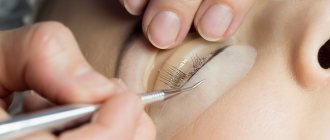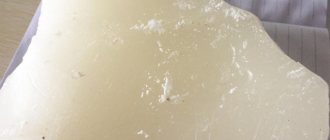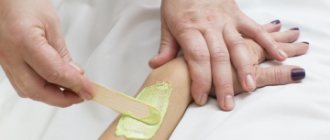It is simply impossible to achieve a perfect manicure and smooth hand skin without deep and systemic moisturizing. The paraffin therapy procedure, which can be done both at home and in the salon, copes with the task. It seems to seal moisture in the upper layers of the skin, soften, relax, relieve pain and irritation. We will talk about these and other features of the procedure, as well as the stages of its implementation, further in detail.
What is paraffin therapy, its types
The paraffin therapy procedure can be divided into two main categories - therapeutic and cosmetic options.
The first is carried out under the supervision of phthisiatricians, and the second is offered as a care procedure in spa centers, beauty salons, and simply for home use.
In general, this is a physiotherapeutic procedure, which is based on the effect of heat on the superficial and deep layers of the skin, muscles and joints.
- Therapeutic paraffin therapy is prescribed as a set of procedures to improve metabolism in tissues and relieve inflammatory processes in joints. It is also an excellent preparation for therapeutic massage.
- Cosmetological paraffin therapy for hands is a simplified version of treatment and provides the opportunity for high-quality and effective skin care, as well as relaxation of muscle tension.
The effect is achieved by applying several layers of paraffin heated to a liquid state. The effect of a warm mask is prolonged by using plastic gloves and terry mittens or towels for 15 to 40 minutes.
Application of paraffin in medicine
Paraffin applications and wraps are widely used in medicine and cosmetology. Due to its beneficial properties, paraffin is used to treat various types of diseases. For example, the procedure is used for bone fractures for rapid healing of injury, for ruptured ligaments, neuralgic disorders, chronic bronchitis and pneumonia, for adhesions after operations, for the treatment of female gynecological diseases, and for skin diseases of almost any nature.
Practicing cosmetologists and numerous beauty salons use paraffin to maintain youth and turgor of the skin of their clients, as well as to combat cellulite on the thighs, buttocks and abdomen.
Who is paraffin therapy recommended for: 10 popular cases
The procedure will be extremely useful in the following situations:
- If you have dry, cracked hand skin
- The skin is often exposed to temperature changes (during the off-season and winter)
- You don't use gloves when doing housework
- Frequently expose your hands to chemical detergents and water
- Need to quickly get your hands in order before an important event or event
- How to thoroughly prepare and warm up before a hand massage
- As one of the stages of performing a spa manicure in a salon
- It is necessary to relieve mild redness and irritation caused by dry skin.
- To relieve mild joint pain due to arthritis or minor sprains
- I want to relax, take care of myself and lift my spirits.
Types of SPA manicure, how it is done and necessary cosmetics
Benefits of paraffin therapy for hands
Initially, paraffin therapy was used for the joints of the hands, it alleviated the condition of arthritis and arthrosis, eliminated swelling, removed bumps, and made bruises less noticeable after injections and blood draws. This method was also actively used to treat frostbite. Nowadays, cosmetic rather than medicinal purposes are more often pursued.
Indications for paraffin therapy for hands:
- dry, chapped skin;
- cracks, small wounds;
- wrinkles, decreased turgor, other signs of aging;
- uneven pigmentation;
- hard, unruly cuticle;
- problems with nails (foliation, slow growth).
The benefits of paraffin therapy for hands are obvious. This is one of the easiest ways to restore youth and beauty to the skin, if there are no contraindications to it.
Contraindications
It is better for you to abandon paraffin therapy for your hands and find other analogues of care for the following conditions or diseases:
- Poor blood circulation in the extremities
- Hand numbness
- Wounds, burns
- Infectious inflammations
- Rash, redness of unknown origin
- Severe allergic reactions to cosmetics
- High blood pressure
- Diabetes
- Increased sensitivity of the skin of the hands.
Hot manicure - how to do it, what products are needed
Cosmetic and aromatic additives for paraffin therapy
Ready-made paraffin can be sold with additives, the most popular of which are:
- Beeswax
- Milk proteins
- Peach, rose, apricot kernel, shea, coconut, tea tree, cocoa oil
- Vitamins A and E
- Mineral complexes
- Herbal extracts
- Dyes and flavors
Vitamins promote rejuvenation, nutrition and active regeneration of the skin. You can purchase vitamins in capsules and add them either to the bath, or mix them with cream or oil, which is applied to the skin of your hands before immersion.
Herbal extracts moisturize the skin and improve the absorption of nutrients from cosmetics used in the procedure.
Minerals increase tone, nourish and promote increased blood circulation. Usually they come in ready-made cosmetic complexes.
You can make your own paraffin with additives if you have them on hand. The desired ingredients are added to the finished bath with the molten product.
Cocoa, menthol, citrus oils - tone the skin, peach, coconut oil and vitamin E - intensively nourish. Tea tree heals scars and disinfects, while grape seed and rose oil moisturize.
In combination with cosmetic ones, aromatic oils can be used to have a gentle effect on the nervous system and improve mood and tone in general. The most neutral ones are citrus fruits, lavender, vanilla, tea tree. They gently soothe and improve your mood, charging you with additional energy. It is enough to add 2-5 drops to a heated bath, and the aroma will spread throughout the room.
Is special training needed?
Yes, it won’t take much time and will better prepare the skin for the procedure. Before paraffin therapy, wash your hands thoroughly with soap. Remove rings and other jewelry, remove clothing from the possible treatment area.
If the procedure precedes a manicure, then you need to remove the nail polish and treat your hands with a fine scrub. Apply a light nourishing or moisturizing cream. Its impact will increase significantly under a paraffin mask due to the greenhouse effect. Now you can get started.
Materials for the procedure in the salon
If you are performing the procedure at home for yourself or for clients who have had pedicures, vary the list accordingly. A basic set for paraffin therapy of the feet, which the specialist will need in the salon:
- Disposable gloves;
- Hand sanitizer and foot sanitizer;
- Paraffin bath for the procedure;
- Plastic bags for feet;
- Terry socks or felt boots (can be replaced with a terry towel);
- Brush for working hard-to-reach areas;
- Medium grind scrub;
- Acid scrub or keratolytic;
- Coconut oil or nourishing cream;
- Paraffin in briquettes per procedure.
Paraffin therapy kit: what a master needs for the procedure
Coconut oil can be replaced with cocoa or olive oil. It will be required for application to the skin before immersion in paraffin. For dry skin on the feet and small cracks, you can additionally use Panthenol, applying it before applying the oil. You can also use sea buckthorn oil for small cracks; it has a pronounced healing effect.
How to do it at home: step by step guide
For the procedure you will need:
- Container to melt paraffin
- Paper napkins or towels, terry towel or mittens
- Polyethylene gloves
- Paraffin at the rate of 150-200 g per procedure
- Brush for hard to reach areas
- A container or bath for paraffin to carry out the procedure. About how to choose and correctly use a paraffin bath.
Stages of paraffin therapy:
- Melt the paraffin in the microwave or in a water bath to a temperature of 45-55 degrees. The task is simplified if you have a special bath. It will adjust the temperature automatically.
- Test the temperature of the product on the back of your hand. If you plan to use oils, vitamins or other supplements, mix them with liquid paraffin.
- Place your hands up to your hands in the container for 5 seconds, then take it out and wait 5-10 seconds for the layer to harden well.
- Repeat the previous steps 5 to 10 times.
- Take your hands and put plastic bags or mittens on the still warm, but already frozen wax.
- Put terry mittens over them or wrap your hands in a towel.
- Find a comfortable position and wait 15 to 40 minutes for maximum effect. Often 30 minutes is enough.
- Remove the paraffin masks from the wrist to the fingers.
- Remove any remaining paraffin with paper towels, lightly rinse your hands with water and blot with a napkin to remove the film of toxins and breakdown products from the skin regeneration process.
- Apply nourishing cream or cosmetic oil to your hands and cuticle skin. Now the pores of the skin are open for the effective influence of caring and medicinal cosmetics.
- Give a light or intense hand massage at your discretion.
How to do paraffin therapy for the face and the necessary products
How to make a paraffin face mask correctly -
Important: for the procedure, only special cosmetic wax is used specifically for the face, intended specifically for use at home.
You must carefully read the instructions for the wax, and pay special attention to the temperature to which it needs to be heated. Paraffin facial therapy: video
How is the procedure performed? –
- The skin of the face and neck must be cleansed with a special cleanser. Thorough washing ensures that dirt, dust, and traces of cosmetics do not clog pores and cause inflammation.
- Before applying a paraffin face mask, reviews from some cosmetologists recommend applying a cosmetic cream or lotion to the skin, which will help additionally nourish the skin with beneficial substances. You can also add your favorite cosmetic and essential oils to the paraffin itself, which will provide additional effects to the procedure.
- Heat the wax in a paraffin bath to the desired temperature. Before applying to the face, check the temperature of the paraffin. To do this, it is recommended to apply heated paraffin to the back of your hand - it should be pleasantly warm, but not hot.
- Warm paraffin is applied to the facial skin with a special brush, along massage lines, avoiding the eye area, mouth and around the nose, so that you can breathe freely during the procedure. Start applying paraffin from the middle of the chin, moving up to the cheeks and ears. The chin is covered last.
- Typically 3-4 layers of paraffin are applied, and the resulting paraffin face mask should be about 5mm thick. Paraffin wax may be too thin and drip, so use old or unwanted T-shirts during the procedure.
- Typically, a paraffin facial mask should remain on your skin for 10-15 minutes or until it sets completely. After which it is carefully removed from the face completely or in parts, starting from the chin.
- After the procedure, it is recommended to apply a moisturizer to the skin. In winter, after the procedure, it is not recommended to go outside for an hour.
The effect of paraffin therapy
After the procedure, the skin is moisturized, smoothed, cell regeneration occurs and toxins are cleansed.
- Moisturizing is achieved due to the greenhouse effect of paraffin therapy. Heat leads to the expansion of pores and the space between cells, sweat and toxins are released, and the paraffin layer does not allow the liquid to evaporate, returning it again to dry areas. Moisture again penetrates into those cells that need it most. If you also apply an additional moisturizer, its effect will enhance the moisturizing effect.
- The skin is cleansed of toxins due to increased blood and lymph flow. They are released with sweat, but are not absorbed back, but settle on the surface.
- The skin smoothes out and takes on a healthy appearance, swelling goes away due to the removal of excess fluid and decay products from the cells.
- The process of cell and tissue restoration occurs due to increased blood flow. They receive maximum nutrients during and after the procedure from the effects of cosmetic products.
What are cosmetic electric mittens and how to use them
Types of paraffin applications
There are several types of procedures, each of which differs in the method of influence and complex properties.
- Cuvette-application;
- Napkin appliqué;
- Layering;
- Paraffin Bath;
- Paraffin-ozokerite;
- Cosmetology;
- Procedures for children.
The cuvette-application method is based on the use of a special container: a cuvette. Melted paraffin is poured onto the bottom of the cuvette, where the oilcloth has already been placed. The cooled but still soft material is removed from the container and placed on the target area of the patient’s body. Cover with a blanket on top.
The napkin-application method involves the use of gauze towels soaked in paraffin. This method is convenient when the area of the body being treated is large.
Layering of the paraffin mass is done using a brush and is used when small areas are treated
Paraffin baths are used to treat the hands or feet. Pre-treated feet or hands are wrapped in film with layered paraffin and lowered into baths filled with heated paraffin.
The procedure is also used in urology and gynecology.
The paraffin-ozokerite method is based on the use of natural material ozokerite. Such applications allow you to relieve inflammation and quickly restore tissue.
For cosmetic purposes, paraffin applications are used for the hands and face. Thanks to their healing properties, paraffin masks and baths smooth the skin, relieve dryness and flaking, eliminate signs of aging, remove waste and toxins, and accelerate blood flow. Paraffin wraps relieve the skin of cellulite, and also bring visible changes in the resorption of scars and scars.
Paraffin therapy for children is widely used in the treatment of acute respiratory infections and acute respiratory viral infections. Thanks to the warmth that lasts for a long time, these unique paraffin boots help to cope with frequent respiratory diseases.
Healthy Supplements
In many salons, herbal extracts of aloe, lavender, mint, citrus fruits, and tea tree are added to cosmetic paraffin. Vitamins E and A are used, which help restore and nourish the upper layers of the skin.
You can experiment with a number of additives, for example, coconut or shea butter, chocolate, just do a test for an allergic reaction first.
Paraffin for hot and cold paraffin therapy - review of the best
What paraffin is used in paraffin therapy?
Many people have heard about the hot paraffin therapy method. But there is also a method when the already cooled product is applied to the skin. Cold paraffin therapy is considered a complex method, so it is easier to follow the classical scheme: heat the product and apply a liquid solidifying mass to the body.
Manufacturers add ready-made compounds to paraffins, which themselves have a healing effect. For example, the addition of vitamins stimulates skin regeneration, nourishes and moisturizes the epidermis. Seaweed extract effectively fights cellulite. But even without adding additional ingredients, the paraffin mass has a beneficial effect on the skin.
Useful tips
A number of proven tips will make the procedure even more effective.
- The more layers of paraffin you apply to your hands, the easier it will be to remove and the longer the warmth will last. Some masters increase the number of layers to 10 or 12.
- To relieve pain in the joints and wrists, the number of layers should reach 15.
- Place your hands at the same level each time to create a thick edge along the edge. It will be much easier for you to remove the paraffin.
- Do not move your fingers between dips to prevent cracks from forming in the layers.
- If you have dry hands, be sure to apply a moisturizing or nourishing cream to the entire surface and additionally in the cuticle area.
- In detail about what materials, products and accessories are needed for paraffin therapy, as well as the choice of paraffin.
Bath or paraffin heater
There are models for professional and home use. They differ in the number of modes, power and capacity. Usually the bath has two modes - heating and maintaining temperature. In professional conditions, in the second mode, it can stand for up to 10 hours in a row, with a large flow of clients, so as not to reheat the paraffin every time. The average cost of a bath is 2,000 rubles.
The paraffin in the bath should be changed every 2-3 months with an average flow of clients. There is a recommended filling level for the container, which is from 1.5 to 2.5 liters of paraffin. Depending on this, you will have to constantly add new briquettes.
Paraffin used for masks removed from hands is disposed of; it is not returned to the container. Read more about baths for paraffin therapy, their choice and features of use.
Benefits of the "greenhouse effect"
Paraffin is a waxy petroleum product characterized by very low thermal conductivity - 0.26 W/(m K). It is able to retain heat for a long time and transfer it to other bodies, which is the basis of the cosmetic effect of this substance. Paraffin creates a kind of “greenhouse effect” in the treatment area, which has a complex effect on the skin and subcutaneous tissue:
- Removes stagnation of blood and lymph.
- Stimulates the removal of toxins from subcutaneous tissue.
- Relieves swelling and cleanses clogged pores.
- Strengthens cellular metabolism, promoting natural skin rejuvenation.
- Strengthens the walls of blood vessels and capillaries.
- Relieves fatigue and improves muscle tone.
Paraffin therapy is an ideal treatment for dry, dehydrated skin. During the procedure, a large amount of moisture is released, which does not evaporate, but is absorbed by the epidermis, moisturizing and softening it. In addition to moisturizing, paraffin therapy has a lifting effect - the skin is tightened and enlarged pores are narrowed.
The procedure uses highly purified cosmetic paraffin with a melting point of no more than 54 °C. Compresses based on it do not leave burns and provide only a comfortable feeling. Candle paraffin is never used in cosmetology - it contains many impurities harmful to the skin and melts at a temperature of 60–65 ° C.
Highly purified paraffin with low melting point
Paraffin therapy as a skin care procedure is good because it has a minimum of contraindications. These include allergies to the components of the paraffin mixture, which is very rare. This thermal procedure is also prohibited for people who suffer from high blood pressure and varicose veins.
About cosmetic paraffin
What it is?
Cosmetic paraffin is distinguished by powerful pre-cleaning from harmful impurities and dyes. It belongs to premium class products. Often, complexes of vitamins, minerals and trace elements are added to it. There is cosmetic paraffin based on honey, fruit, oil and vegetable. Its action is aimed at eliminating signs of withering and aging of the skin, deeply nourishing it, moisturizing and healing it.
How much paraffin is needed for paraffin therapy at home?
The quantity is calculated per procedure, taking into account the area of application. To carry out the procedure on the hands, on average you will need 150-200 g of product. For the face you will need approximately the same amount, given its mandatory application in several layers.
Changing paraffin should be accompanied by thorough cleaning of the bath. And it doesn’t matter whether you use a special bath or another suitable container (at home). The material should be changed according to the instructions, but this should not be done too often - some companies recommend replacing every 25-30 uses, some 2-3 times a year.
The treatment bath is cleaned when replacing the product, or if sediment has formed at the bottom.
To do this, turn off the device and wait until the paraffin hardens well. Then run the bath for a few minutes to allow the edges of the substance to melt. Now carefully pry up the paraffin monolith and remove it. All that remains is to remove the remaining product with a napkin, wash the container, disinfect and dry. If you want to reuse the removed cosmetic wax, first scrape off the sediment from the bottom.
Which paraffin to choose for paraffin therapy at home?
Paraffin for use at home should be selected depending on the purpose of use. For allergy sufferers and people suffering from inflammatory processes, a product based on peach oil is suitable. The product with the addition of tocopherol and tea rose extract is excellent for SPA treatments aimed at treating the skin of the hands and feet. Paraffin with citrus additives has an additional nourishing effect and is suitable for the treatment of hands, feet and body. The chocolate product ensures skin regeneration and renewal at the cellular level. Choose the right product for paraffin therapy at home based on your preferences.
How to reheat?
For paraffin therapy, a special bath is usually used. An alternative at home is a regular water bath. The container with paraffin is placed on a colander, which is located above the steam of boiling water. This may take a little longer, but if a special device is not available, steam heating is also suitable. With this type of heating, care must be taken to ensure that no water gets into the paraffin.
Paraffin bath











